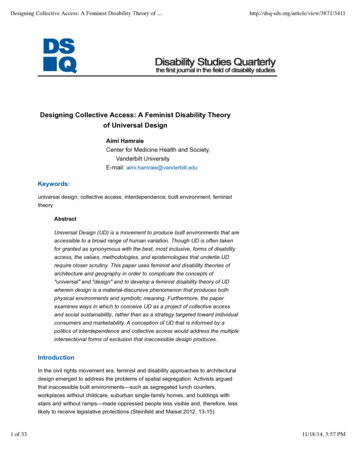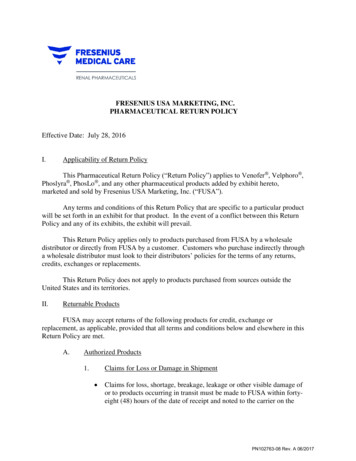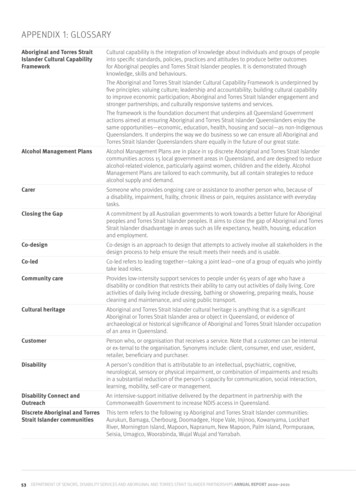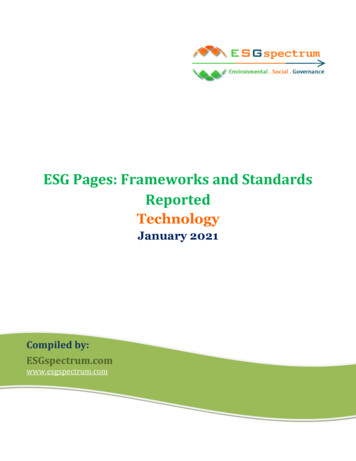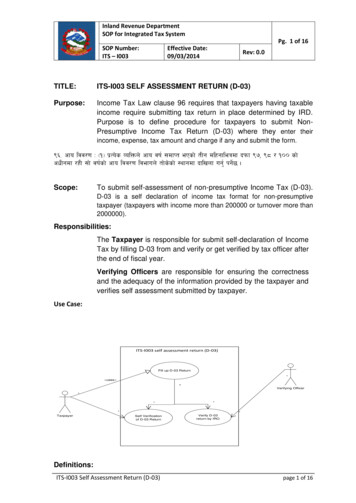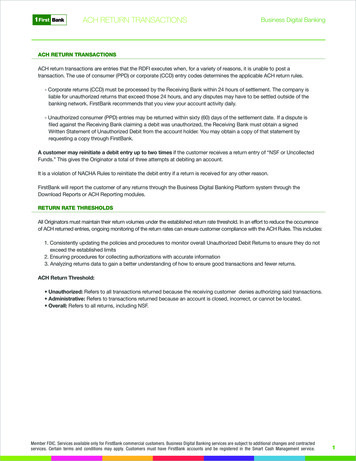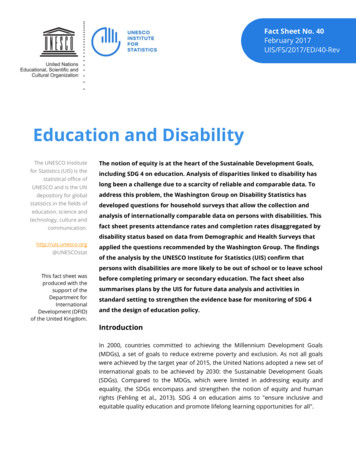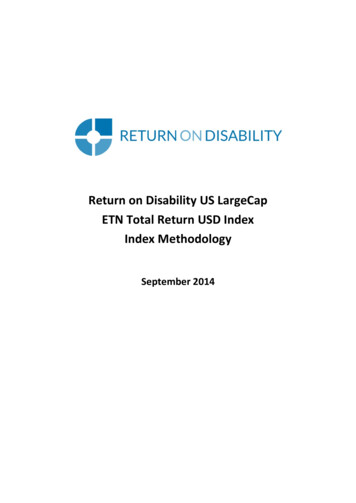
Transcription
Return on Disability US LargeCapETN Total Return USD IndexIndex MethodologySeptember 2014
Table of ContentsIntroduction3Part A - Definitions4Part B - Index Constituent Selection1. Index Composition92. Determination of the Weights13Part C – General Rules1. Index Adjustment Event or Index Market Disruption Event152. Change in Methodology153. Change in Index Calculation Agent164. Index Announcements and Adjustments165. Tickers16Appendix 1 – Adjustment for Corporate Actions1. Definitions172. Choice between cash and stock distribution173. Adjustment for not specified Corporate Actions174. Adjustment formulae18Appendix 2 – Index Committee23Disclaimer242
IntroductionDonovan Group LLC indices are designed to capture the shareholder value creation indicated by publicallytraded firms acting in the global market of disability. Companies in the Return on Disability Indices areconsidered by Donovan Group to be the top firms in disability with respect to creation of shareholdervalue. The Return on Disability US LargeCap ETN Total Return USD Index is an equal weighted equity index.It identifies the top 100 publicly traded large-cap companies in the United States with respect to disabilityas it relates to creation of shareholder value using a publically disclosed research model called the Returnon Disability Binary model.The indices should be fair, meaning that an investor who buys all the stocks in an index with correct indexweights can achieve the same performance that Donovan Group or its designee calculates.3
PART A – DefinitionsFor the purposes of these Index Rules:“Announcement Date” means a date that is twenty Index Business Days before the last date of the fourthquarter of each fiscal year (i.e. twenty Index Business Days prior to the last day of December each year),where the Index Owner shall publically announce the new Index Constituents;“Annual Dollar Value Traded” means for any Share the sum of the Daily Turnover for each Index BusinessDay for the preceding year for as determined by the Index Calculation Agent;“Basket” means the basket of Shares, constituting the relevant Index. Shares constituting the Basket areselected from the members of the Share Universe according to the methodology detailed in Part B (IndexConstituent Selection);“Corporate Action” means, without limitation, any dividend, conversion, subscription rights, subdivision,consolidation, redemption, merger, rights relating to takeovers or other offers or capital re-organisation,capitalisation issue, rights issue, redenomination, renominalisation or other event or right which is similarto any of the forgoing items and which affects any Index Constituent;“Daily Turnover” means, for any Share, the daily sum of the products of (i) each trade price of such Shareon the Exchange and any Related Exchanges for such Share and (ii) the traded volume of such trade for suchShare on the relevant Exchange or Related Exchange, as published by Bloomberg (or any successor) in the“TURNOVER” field relating to such Share.“Data Sources” means Bloomberg, Factset, ISS and any other generally available source selected by theIndex Calculation Agent acting in a commercially reasonable manner. The Index Calculation Agent does nottake any responsibility for the accuracy of data sourced from the Data Sources. In the event of datainaccuracy or error made by Data Sources (as determined by the Index Calculation Agent), the IndexCalculation Agent reserves the right to make commercially reasonable adjustment to the data provided bythe Data Sources;“Exchange” means the relevant exchange on which a Share is primarily traded including any successor toany such exchange or quotation system to which trading in any Share has temporarily relocated (providedthat the Index Calculation Agent has determined that there is comparable liquidity for that IndexConstituent on such temporary substitute exchange or quotation system as on the original exchange);“Ex-Date” is the date on, or after which, a stock trades ex-dividend;“General Banking Moratorium” means the declaration of a general moratorium in respect of bankingactivities in London or New York;“Index” means The Return on Disability US LargeCap ETN Total Return USD Index;“Index Adjustment Event” means any of the following events:(a)the Index Calculation Agent determines, at any time, that an Index Force Majeure Event occurs or iscontinuing;(b)the Index Calculation Agent determines, at any time, that there has been (or there is pending) achange in taxation (i) generally affecting commercial banks organized and subject to tax in theUnited Kingdom (including, but not limited to, any tax generally imposed on commercial banksorganized and subject to tax in the United Kingdom), or (ii) affecting market participants in theUnited Kingdom or the United States generally who hold positions in any of the Index Constituents;or(c)a change shall have been made to any of the Index Constituents or there shall have occurred anyother event that would make the calculation of an Index impossible or infeasible, technically or4
otherwise, or that makes an Index non-representative of market prices of the Index Constituents orundermines the objectives of an Index or the reputation of an Index as a fair and tradable index.“Index Base Date” means January 3, 2012 and is the date on which the Index Level for any Index is deemedto have been at 100.0000;“Index Business Day” means any day which is a New York Stock Exchange trading business day, and aNASDAQ trading business day;“Index Calculation Agent” means the entity appointed by the Index Owner to administer, calculate andpublish the Index Level in accordance with these Index Rules, such entity being NYSE Group Inc. and itsaffiliates or any successor thereto;“Index Commencement Date” in respect of an Index, is September 9, 2014.“Index Committee” means the committee formed to oversee the integrity of the rules and provideclarifying guidance on the rules where required, although every effort is made to ensure the rules are clearand non-discretionary;“Index Constituent” means, in respect of an Index, each of the Shares included in such Index and selectedin accordance with Part B (Index Constituent Selection). For the avoidance of doubt, the Index Constituentson each Rebalancing Date during the Rebalancing Period shall be the New Index Constituents and the OldIndex Constituents;“Index Currency” means, in respect of an Index, USD;“Index Force Majeure Event” means an event or circumstance (including, without limitation, a systemsfailure, natural or man-made disaster, act of God, armed conflict, act of terrorism, riot or labour disruptionor any similar intervening circumstance) that is beyond the reasonable control of the Index CalculationAgent and that the Index Calculation Agent determines affects any Index, any Index Constituent or themethodology on which any Index is based or the Index Calculation Agent’s ability to calculate and publishany Index;“Index Level” means, in respect of an Index, the level of The Return on Disability US LargeCap ETN TotalReturnIndex on any Index Business Day.“Index Market Disruption Event” means, with respect to any Index Constituent, the occurrence of one ormore of the following events if, in the determination of the Index Calculation Agent such event is material:(a)a suspension, absence or limitation of trading in (1) such Index Constituent in its primary market,as determined by the Index Calculation agent, or (2) futures or options contracts relating to suchIndex Constituent in the primary market for those contracts, as determined by the IndexCalculation Agent, in either case for more than two hours of trading or at any time during the 30minute period preceding the close of the regular trading session in such market or, if the relevantvaluation time is not the close of the regular trading session in such market, the relevant valuationtime;(b)any event that disrupts or impairs, as determined by the Index Calculation Agent, the ability ofmarket participants in general to (1) effect transactions in, or obtain market values for, such IndexConstituent in its primary market, or (2) effect transactions in, or obtain market values for, futuresor options contracts relating to such Index Constituent in the primary market for those contracts, ineither case for more than two hours of trading or at any time during the 30 minute periodpreceding the close of the regular trading session in such market or, if the relevant valuation time isnot the close of the regular trading session in such market, the relevant valuation time;(c)the closure on any Scheduled Trading Day of the primary market for such Index Constituent prior tothe scheduled weekday closing time of that market (without regard to after hours or any othertrading outside of the regular trading session hours) unless the earlier closing time is announced by5
the primary market at least one hour prior to the earlier of (1) the actual closing time for theregular trading session on such primary market on such Scheduled Trading Day for such primarymarket and (2) the submission deadline for orders to be entered into the relevant exchange systemfor execution at the close of trading on such Scheduled Trading Day for such primary market;(d)any Scheduled Trading Day on which (1) the primary market for such Index Constituent or (2) theexchanges or quotation systems, if any, on which futures or options contracts relating to such IndexConstituent are traded, fails to open for trading during its regular trading session;(e)General Banking Moratorium;(f)the occurrence of an event that makes it impossible or not reasonably practicable on any IndexBusiness Day for the Index Calculation Agent to obtain the price of such Index Constituent, or anyother price for the purposes of calculating the Index Level in a manner reasonably acceptable tothe Index Calculation Agent; or(g)an FX Disruption event occurs. For these purposes, “FX Disruption” means the occurrence of anyevent after the Index Base Date that results in the Index Calculation Agent being unable, afterusing commercially reasonable efforts, to convert a Foreign Currency into the Index Currency onan Index Business Day.The following events will not be Index Market Disruption Events:(i) a limitation on the hours or number of days of trading in the relevant market or relevantexchange only if the limitation results from an announced change in the regular businesshours of the relevant market; and(ii) a decision to permanently discontinue trading in futures or options contracts relating to theIndex or any Index Constituent.For this purpose, an “absence of trading” on an exchange or market will not include any time when therelevant exchange or market is itself closed for trading under ordinary circumstances.In contrast, a suspension or limitation of trading in an Index Constituent in its primary market, or in futuresor options contracts relating to an Index Constituent, if available, in the primary market for those contracts,by reason of any of:(i) a price change exceeding limits set by that market,(ii) an imbalance of orders relating to those securities or those contracts, as applicable, or(iii) a disparity in bid and ask quotes relating to those securities or those contracts, as applicable,will constitute a suspension or material limitation of trading.“Index Owner” means Donovan Group LLC in its capacity as the owner of the intellectual property andlicensing rights relating to the Index;“Liquidity Threshold” means, for each Share, a requirement that (i) the ratio of Annual Dollar Value Tradedon all eligible exchanges to float adjusted market capitalization be 1.00 or greater, and (ii) a minimum of250,000 Shares be traded in each of the six months leading up to the relevant Selection Date;“Market Cap Threshold” is USD 2 billion;“New Index Constituents” means, during a Rebalancing Period, the Shares selected on the immediatelystpreceding Selection Date that are to be held with respect to the 1 Rebalancing Date of the currentRebalancing Period, in accordance with Section 2 (Index Rebalancing) of Part C (Index CalculationMethodology);6
“Old Index Constituents” means, during a Rebalancing Period, the current Index Constituents as selectedon the Selection Date immediately preceding the most recent Rebalancing Date in accordance with Section2 (Index Rebalancing) of Part C (Index Calculation Methodology);“Ordinary Cash Dividend” means, a regular scheduled cash dividend, as declared by the issuer of therelevant Share;“Price” means, in respect of a Share, the official closing price of such Share on the Exchange on any tradingday. If such price is not denominated in the relevant Index Currency, the Index Calculation Agent shallconvert the price to the Index Currency by applying the relevant Currency Spot Rate;“Rebalancing Date” means each Index Business Day included in the Rebalancing Period;“Rebalancing Period” means a period of four consecutive Index Business Days starting from the secondIndex Business Day of every March, June, September and December. In addition December will include newIndex Constituents selected on the Selection Date. If such day is not an Index Business Day, then theimmediately following Index Business Day will be selected subject to the provisions in Part C (GeneralRules);"Related Exchange" means in relation to a Share, each exchange, or quotation system other than anExchange where the Share is traded or where trading has a material effect (as determined by the IndexCalculation Agent acting in a commercially reasonable manner) on the overall market for futures or optionscontracts relating to that Share;“Relevant Region” means, in relation to an Index, the United States of America;“Scheduled Trading Day” means, with respect to an Index Constituent, any day on which the primarymarket for such Index Constituent is scheduled to be open for trading for its regular trading session, asdetermined by the Index Calculation Agent;“Selection Date” means a date that is twenty five Index Business Days before the last date of the fourthquarter of each fiscal year (i.e. twenty five Index Business Days prior to the last day of December eachyear), the Index Owner shall determine a list of stocks according to PART B – Index Constituent Selectionbelow based on the relevant data after the close of trading, 4:15pm New York time“Share Currency” means, in relation to a Share, the currency in which such Share is quoted on theExchange;“Share Issuer” means, in relation to a Share or Index Constituent, the issuer of such Share or IndexConstituent;“Share Universe” means those Shares for each Index as described in Section 1.1 of Part B (IndexConstituent Selection);“Shares” means, any ordinary shares or stocks listed on an Exchange and ineligible shares include REITs,limited partnerships, master limited partnerships, OTC bulletin board issues, closed-end funds, exchangetraded funds, exchange-traded notes, royalty trusts, tracking stocks, preferred shares, unit trusts, equitywarrants, convertible bonds, investment trusts, American Depositary Receipts (ADRs), American DepositaryShares (ADSs), mortgage REITS and master limited partnership investment trust units;“Special Cash Dividend” has the meaning described in Section 4.3 of Appendix 1;”USD” means the United States dollar.“US Fed Fund Effective Rate” means the interest rate at which depository institutions lend balances to eachother overnight, published on Bloomberg page FEDL01 Index;“Withholding Tax Rate” is intended to represent the rate of tax levied by any relevant governmental orother taxing authority on a stock dividend payment without regard to the effect of any relevant treaty7
between authorities in any relevant jurisdiction. The Index Calculation Agent will determine theWithholding Tax Rate by reference to such publicly available information sources as it deems appropriate.In the event of any inconsistency between the rate displayed on the information sourced used by the IndexCalculation Agent for purposes of this definition and the actual rate of tax levied on a stock dividend by anyrelevant governmental or other taxing authority, the Index Calculation Agent may rely on and use the ratedisplayed by such information source. If for any reason the Withholding Tax Rate is unavailable from anypublicly available information sources that Index Calculation Agent deems to be appropriate, the IndexCalculation Agent shall determine the Withholding Tax Rate in a commercially reasonable manner byreference to such factors as the Index Calculation Agent deems appropriate. The Withholding Tax Rate issubject to change from time to time.8
PART B – Index Constituent Selection1.Index CompositionThis section describes how the Index Constituents on each Selection Date are selected out of the ShareUniverse and how the number of Shares for each Index Constituent is determined in order for each Index toreflect the performance of a portfolio of US stocks with The “Sub-Universe” shall be determined byselecting the Shares in the Share Universe which meet the Market Capitalisation and Liquidity Criteria andapplying the Single Issuer Constraint as detailed below.(1)Market Capitalisation and Liquidity Criteria The market capitalisation of a Share in the Share Universe on the Selection Date mustbe equal to or over the Market Capitalisation Threshold (the “Market Capitalisation”); and The Share in the Share Universe on the Selection Date must meet the LiquidityThreshold (the “Liquidity Criteria”); andThe Index Sponsor shall determine which Shares meet the Market Capitalisation and LiquidityCriteria on the basis of data from Bloomberg (or any successor Data Source) on the Selection Date.If the Index Sponsor determines that any required information in relation to a Share is notavailable on the Bloomberg (or any successor Data Source), that Share shall be excluded fromfurther analysis and shall not form part of the Sub-Universe.(2) Single Issuer ConstraintIf, after application of the Market Capitalisation and Liquidity Criteria set out above, more than oneclass of Shares or more than one listing of a Share issued by the same Share Issuer remains, thenthe Index Sponsor will select the class or listing of Share which it determines is most appropriate tobe included in the “Sub-Universe”. Such determination is based on, the following criteria: Liquidity (as determined by reference to the Three Month Average Daily ValueTraded): the most liquid class or listing of Share of the Share Issuer will be selected.(3) DomicileU.S. companies. For index purposes, a U.S. company has the following characteristics: File 10-K annual reports and should not be considered foreign entity by SEC. The primary listing of the common stock is the NYSE (including NYSE Arca and NYSEMKT), the NASDAQ Global Select Market, the NASDAQ Select Market or the NASDAQCapital Market. ADRs are not eligible for inclusion. A corporate governance structure consistent with U.S. practice.(4) Treatment of IPOsInitial public offerings are immediately eligible for index inclusion subject to (1) and (2) above.(5) ProfitabilityThe Share company must have “financial viability,” which is usually measured as four consecutivequarters of positive as-reported earnings. As-reported earnings are determined by reference toGenerally Accepted Accounting Principles (GAAP) net income excluding discontinued operationsand extraordinary items.(6) Return on Disability RankingAs defined by a proprietary model via The Index Owner, all firms in the universe (as below) are given aresult of observation (a ‘score’ between 0 and 1) reflecting said firm’s action in the disability market with9
respect to creation of shareholder value. These firms are then ranked, from highest to lowest, with the top100 scores meeting substantially all of the below criteria making up the constituents of the index.The Index Owner creates an initial list of stocks of companies that have met substantially all the criteria setforth below and ranks them based on the Return on Disability Binary Result which ranks companies basedon their (a) talent binary score, (b) customer binary score and (c) productivity binary score. Each of thesescores is described further immediately below.(a) Talent Binary ScoreThe talent binary score has two components: (1) attract and hire and (2) getting the firm ready. ‘Attract andhire’ refers to basic activities that any company can engage in to cause people with disabilities to apply foropen positions and results in the company hiring these individuals. ‘Getting the firm ready’ refers to effortsto prepare the physical and cultural environment of a company to increase the chance of success foremployees with disabilities, their managers and their colleagues. These efforts must be publicallyobservable independent of the target company’s direct input. Each company is evaluated for eachcomponent based on the criteria described below. If a company meets the criteria of a particular category,they receive a score of a “1” for that component. If a company does not meet the criteria for a particularcategory, they receive a score of a “0” for that component. Each criteria is sourced, complied andcalculated by the Index Owner as described below.Attract and Hire (must meet 2 of the 3 criteria below to receive a score of “1”)1. Exists formal process to interview candidates with disabilities with published numbers. Sourced: Company statements, websites and partner relationships Compiled: Annual audit independent of company Calculated: Visible alternate contact info, successful partners2. Statement of actual hires of persons with disabilities with published numbers. Sourced: Company statements, government reports Compiled: Annual audit independent of company Calculated: Self-reporting publicly, affirmative action audits3. Career-focus message to attract persons with disabilities (for example, certain companies partner withorganizations to attract candidates with business/talent-driven messages, internships and scholarships) Sourced: Company statements, websites and partner relationships Compiled: Annual audit independent of company Calculated: Non-legal messaging by – or on behalf of – companyGetting the Firm Ready (must meet 1 of 3 criteria below to receive score of “1”)1. Roll from curb to interview without barrier. Sourced: Company headquarter visit Compiled: Annual audit independent of company (as needed) Calculated: No steps, auto door, reception process2. Business-focused message to employees. Sourced: Company statements10
Compiled: Annual audit independent of company Calculated: Self-reporting publicly3. Legal compliance. Sourced: Company statements, websites and lawsuits Compiled: Annual audit independent of company Calculated: Statement of effort by company, government lawsuit settled/lost(b) Customer Binary ScoreThe customer binary score has two components: (1) product development and (2) customer experience.‘Product development’ refers to action taken by the firm to gather and utilize insights from people withdisabilities to improve the over-all user experience of a firm’s core product or service. ‘Customerexperience’ refers to efforts by the company to manage the interactions within retail, broadcast and onlineenvironments where customers interact with brands and purchase products include the demands of peoplewith disabilities and act on their desires for branded experiences. These efforts must be publicallyobservable independent of the target company’s direct input.Each company is evaluated for eachcomponent based on the criteria described below. If a company meets the criteria of a particular category,they receive a score of a “1” for that component. If a company does not meet the criteria for a particularcategory, they receive a score of a “0” for that component. Each criteria is sourced, complied andcalculated by The Index Owner as described below under each component.Product Development (must meet 1 of 3 criteria below to receive a score of “1”)1. Evidence of access features in product (for example, makers of electronic goods include multiple featuresto allow their products to be used by people with disabilities as part of their software programming). Sourced: Feature audit, 3rd party public reviews (expert & lay) Compiled: Annual audit (independent of company) Calculated: Functional needs met while delighting core customer2. Evidence of access features in service offering. Sourced: Feature audit, 3rd party public reviews (expert & lay) Compiled: Annual audit independent of company Calculated: Functional needs met while delighting core customer3. Evidence of access features in packaging (for example, consumer goods firm designs packaging thatmakes their product easily accessible for people with disabilities). Sourced: Feature audit, 3rd party public reviews (expert & lay) Compiled: Annual audit independent of company Calculated: Functional needs met while delighting core customerExperience (must meet 1 of the 2 criteria below to receive a score of “1”)1. At least 1 person with disability ‘mention’ in primary-channel advertisements (i.e., mainstreamadvertisements include people with disabilities) Sourced: Public advertisements (5 years) Compiled: Annual audit independent of company Calculated: Text, audio or visual cue11
2. At least 2 retail access enhancements. (actual or test) Sourced: Audits of retail environments (secret shopper) Compiled: Annual audit independent of company Calculated: Non-ADA activity that improves core shopping experience(c) Productivity Binary ScoreThe productivity binary score has two components: (1) employee tools and (2) process change. ‘Employeetools’ refers to basic activities that any company can engage in to cause people with disabilities to be asproductive as possible and put in place the corporate infrastructure to capture/foster future productivityenhancements. ‘Process change’ refers to efforts to employ people with disabilities and leverage theirtalents and insights to drive down costs in process-heavy environments. These efforts must be publicallyobservable independent of the target company’s direct input. Each company is evaluated for eachcomponent based on the criteria described below. If a company meets the criteria of a particular category,they receive a score of a “1” for that component. If a company does not meet the criteria for a particularcategory, they receive a score of a “0” for that component. Each criteria is sourced, complied andcalculated by The Index Owner as described below under each component.Employee Tools (must meet 1 of the 2 criteria below to receive a score of “1”)1. Published accommodations process. Sourced: Company statements, websites and partner relationships Compiled: Annual audit independent of company Calculated: Visible accommodation statements/features, public case studies2. Existence of an Employee Resource Group. Sourced: Company statements, media reports Compiled: Annual audit independent of company Calculated: Firm reported or mediaProcess Change (must meet both of 2 criteria below to receive a score of “1”)1. Public statements that firm captures process innovation from persons with disabilities to increaseproductivity (for example, a company mentions on their website that productivity gains have been made indistribution centers as a result of hiring persons with disabilities). Sourced: Company statements, websites and partner relationships Compiled: Annual audit independent of company Calculated: Aware of productivity enhancements and actively seeking2. Piloted in at least one facility on an ongoing basis. Sourced: Company statements, websites and partner relationships Compiled: Annual audit independent of company Calculated: Statement of pilotAs shown below in Tables 1 and 2 the weight given to each of the three scores and the two componentswhich comprise each score varies depending on the industry that each company operates in.12
After the weight is applied to each score and component as shown in the table above, The Index Ownerthen ranks the companies from highest to lowest (the “RoD Ranking”). The top 100 stocks in the RoDRanking (the “index components”) will be included in the Index beginning on the next reconstitution date(as defined below) which is ten trading days after the index Announcement Date. The index componentswill be included in the RoD Index for twelve months after the reconstruction date until the next annualrebalancing date, subject to the deletion procedures described below. In the event that two Return onDisability Rankings are the same, the stock with the highest “financial viability,” which is usually measuredas the last quarters as-reported earnings, will be selected. As-reported earnings are determined byreference to Generally Accepted Accounting Principles (GAAP) net income excluding discontinuedoperationsandextraordinaryitems.Table 1Table 22Determination of the WeightsThe weight of each newly selected Share is determined on the relevant Selection Date. The new Sharesselected are equally weighted.The final weights of the new Shares selected are calculated according to the following iterative procedure:Step 1: A first set of weights is calculated as follows:w(i1) 1NWhere: N is the total number of new Shares selected.13
The Index owner will declare new Index Constituents on the Annocument Date as per Part D General Rulesin section 4: Index Announcements and Adjustments14
Part C – General Rules1.Consequences of Index Adjustment Event, Index Market Disruption Event1.1If an Index Adjustment Event occurs on any Index Business Day that the Index Calculation Agentdetermines, affects an Index, the Index Calculation Agent may:1.21.1.1make such determinations and/or adjustments as the Index Calculation Agent considersnecessary in order to maintain the objectives of such Index, in relation to (a) themethodology used to calculate
on Disability Binary model. The indices should be fair, meaning that an investor who buys all the stocks in an index with correct index weights can achieve the same performance that Donovan Group or its designee calculates. 4 . a decision to permanently discontinue trading in futures or options contracts relating to the Index or any Index .

